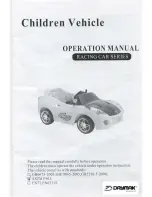
Power 10 Brushless Outrunner Instructions
Thank you for purchasing the E-flite Power 10 Brushless Outrunner motor. The Power 10 is designed to deliver clean and quiet power for 10-size sport and
scale airplanes weighing 32- to 48-ounces (910- to 1360-grams), 3D airplanes 28- to 36-ounces (790- to 1020-grams), or models requiring up to 450 watts
of power. It’s an especially good match for the E-flite Ultimate 20-300 10e.
Power 10 Brushless Outrunner Features:
• Equivalent to a 10-size glow engine for 32- to 48-ounce (910- to 1360-gram) airplanes
• Ideal for 3D airplanes 28- to 36-ounces (790- to 1020-gram)
• Ideal for models requiring up to 450 watts of power
• High torque, direct drive alternative to inrunner brushless motors
• Includes mount, prop adapters, and mounting hardware
• Quiet, lightweight operation
• External rotor design, 5mm shaft can easily be reversed for alternative motor installations
• High quality construction with ball bearings and hardened steel shaft
• Slotted 12-pole outrunner design
Power 10 Specifications
Diameter:
35mm
(1.4
in)
Case Length: 42mm (1.6 in)
Weight: 122g (4.3 oz)
Shaft Diameter: 5mm (.2 in)
EFLM4010A
Kv: 1100 (rpms per volt)
Io: 2.10A @ 10V (no load current)
Ri: .04 ohms (resistance)
Continuous Current: 32A*
Max Burst Current: 42A*
Watts: up to 450
Cells: 2-3S Li-Po or 6-10 Ni-MH/Ni-Cd
Recommended Props: 10x5 to 12x6 Electric
Brushless ESC: 40 Amp
* Maximum Operating Temperature: 220 degrees Fahrenheit
* Adequate cooling is required for all motor operation at maximum current levels.
* Maximum Burst Current duration is 15 seconds. Adequate time between maximum burst intervals is required for proper cooling and to avoid overheating
the motor.
* Maximum Burst Current rating is for 3D and limited motor run flights. Lack of proper throttle management may result in damage to the motor since
excessive use of burst current may overheat the motor.
Determine a Model’s Power Requirements:
1. Power can be measured in watts. For example: 1 horsepower = 746 watts
2. You determine watts by multiplying ‘volts’ times ‘amps’. Example: 10 volts x 10 amps = 100 watts
Volts x Amps = Watts
3. You can determine the power requirements of a model based on the ‘Input Watts Per Pound’ guidelines found below, using the flying weight of the model (with battery):
•
50-70 watts per pound; Minimum level of power for decent performance, good for lightly loaded slow flyer and park flyer models
•
70-90 watts per pound; Trainer and slow flying scale models
•
90-110 watts per pound; Sport aerobatic and fast flying scale models
•
110-130 watts per pound; Advanced aerobatic and high-speed models
•
130-150 watts per pound; Lightly loaded 3D models and ducted fans
•
150-200+ watts per pound; Unlimited performance 3D and aerobatic models
NOTE: These guidelines were developed based upon the typical parameters of our E-flite motors. These guidelines may vary depending on other motors and factors such as
efficiency and prop size.
4. Determine the Input Watts Per Pound required to achieve the desired level of performance:
Model: E-flite Ultimate 20-300
Estimated Flying Weight w/Battery: 2.5 lbs
Desired Level of Performance: 150-200+ watts per pound; Unlimited performance 3D and aerobatics
2.5 lbs x 150 watts per pound = 375 Input Watts of total power (minimum)
required to achieve the desired performance
5. Determine a suitable motor based on the model’s power requirements. The tips below can help you determine the power capabilities of a particular motor and if it can provide
the power your model requires for the desired level of performance:
•
Most manufacturers will rate their motors for a range of cell counts, continuous current and maximum burst current.
•
In most cases, the input power a motor is capable of handling can be determined by:
Average Voltage (depending on cell count) x Continuous Current = Continuous Input Watts
Average Voltage (depending on cell count) x Max Burst Current = Burst Input Watts
HINT: The typical average voltage under load of a Ni-Cd/Ni-MH cell is 1.0 volt. The typical average voltage under load of a Li-Po cell is 3.3 volts. This means the typical average
voltage under load of a 10 cell Ni-MH pack is approximately 10 volts and a 3 cell Li-Po pack is approximately 9.9 volts. Due to variations in the performance of a given battery, the
average voltage under load may be higher or lower. These however are good starting points for initial calculations.






















